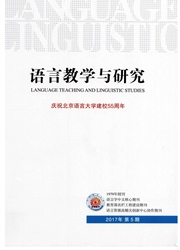

 中文摘要:
中文摘要:
本文主要运用功能主义和认知语言学的方法,从现象出发讨论了协同动词带宾语现象的语义后果、机制和动因。我们认为,协同动词带宾语现象的语义后果是动词前后两个NP分别地“施事化”和“(准)受事化”以及它们各自的话题化和焦点化。我们把这些语义后果都视为NP1和NP2深层认知上的显著性在不同层面的投射。最后,我们把协同动词带宾语现象的语法机制归结于句式的套用和词项的代入,语用动因归结为表达上的简洁性和表意准确的要求。
 英文摘要:
英文摘要:
This paper focuses on the semantic effects, mechanism and motivation of the phenomenon of collaborative verbs followed by objects on the basis of functionalism and cognitive linguistics. It is argued in the paper that the major semantic effects of the structures are the respective agentization and patientization of the two NPs and their individual topicalization and focalization. These semantic effects are projected into different levels of the prominence of the deep cognition of these two NPs. The grammar mechanism of this phenomenon is attributed to expression elaboration and lexicon insertion, and the pragmatic motivation of this phenomenon is attributed to the request of economy and accuracy of expressions.
 同期刊论文项目
同期刊论文项目
 同项目期刊论文
同项目期刊论文
 期刊信息
期刊信息
